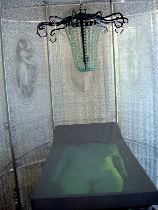
I stopped in at Esther Klein Gallery yesterday to check out the “Teatro Anatomico” installation by Cristin Millett. (See gallery’s website for more pictures.) A sign posted outside the installation said the piece was not working and to try again another time but I doggedly snooped around and entered the maze of scrims printed with antique anatomy drawings anyway just to check it out.
What’s at the heart — or in the womb — of this Victorian labial labyrinth is a standard-issue hospital examination table that sits under a lamp that evokes eggs and tubes — metaphorical female plumbing. Projected onto the top of the exam table is the image of a naked torso (neck to thighs) of a woman. The image is so still I thought at first it was a slide projection but indeed it is a video projection and the headless woman breathes in and out and lies there quietly. In time the image is altered and a new video “window” is opened up in the body above the pelvis. Here’s where the action occurs, as, through this second inset window you see a surgeon’s hands operating on a body, maybe this beautiful body. The surgical window opens and closes quickly and the original pristine image carries on, the woman breathing calmly as before.

There is shock value, of course, in seeing the blood and tools and surgeon’s hands working away mechanic-like on the image of this previously intact body. But it’s not news here that humans have internal works that need operating on.
Now I suspect what I missed is a live interactive video component where my head (or any viewer’s head) would be projected on the table where the torso’s head should be but isn’t. (I got this idea from an installation photo on the gallery’s website which appears to show just that.) Seeing my head on that torso would have given a bit more shock to the piece — and more personal interest because we all want to look at images of ourselves, so fascinated are we with our visages. Nonetheless, the piece as I saw it was complete enough to deliver the message.
Why the message needs delivering is another question. It seems that the issue of women’s bodies and women’s reproductive rights has been with us for a long time in the art world. The idea of body and pristine and vulnerable has also been around a long time. As has the issue of who owns a woman’s body, the woman, her husband, the doctor, the church.
(We just saw that last one played out in the messy legal fracas surrounding Terry Schiavo.)
So this piece joins a long line of art by women about women’s bodies. (The feminist canon is extensive — Judy Chicago, Lynda Benglis, all those amazing works for the 1960s and 1970s that were in the “Gloria” exhibit that Ingrid Schaffner co-curated)
I hope art about women and womens’ bodies can move into the 21st century a bit and away from glancing back over our shoulders and describing where we have been. “Teatro Anotomico” was created by the artist during a three-month residency at Sculpture Space in Utica NY.









